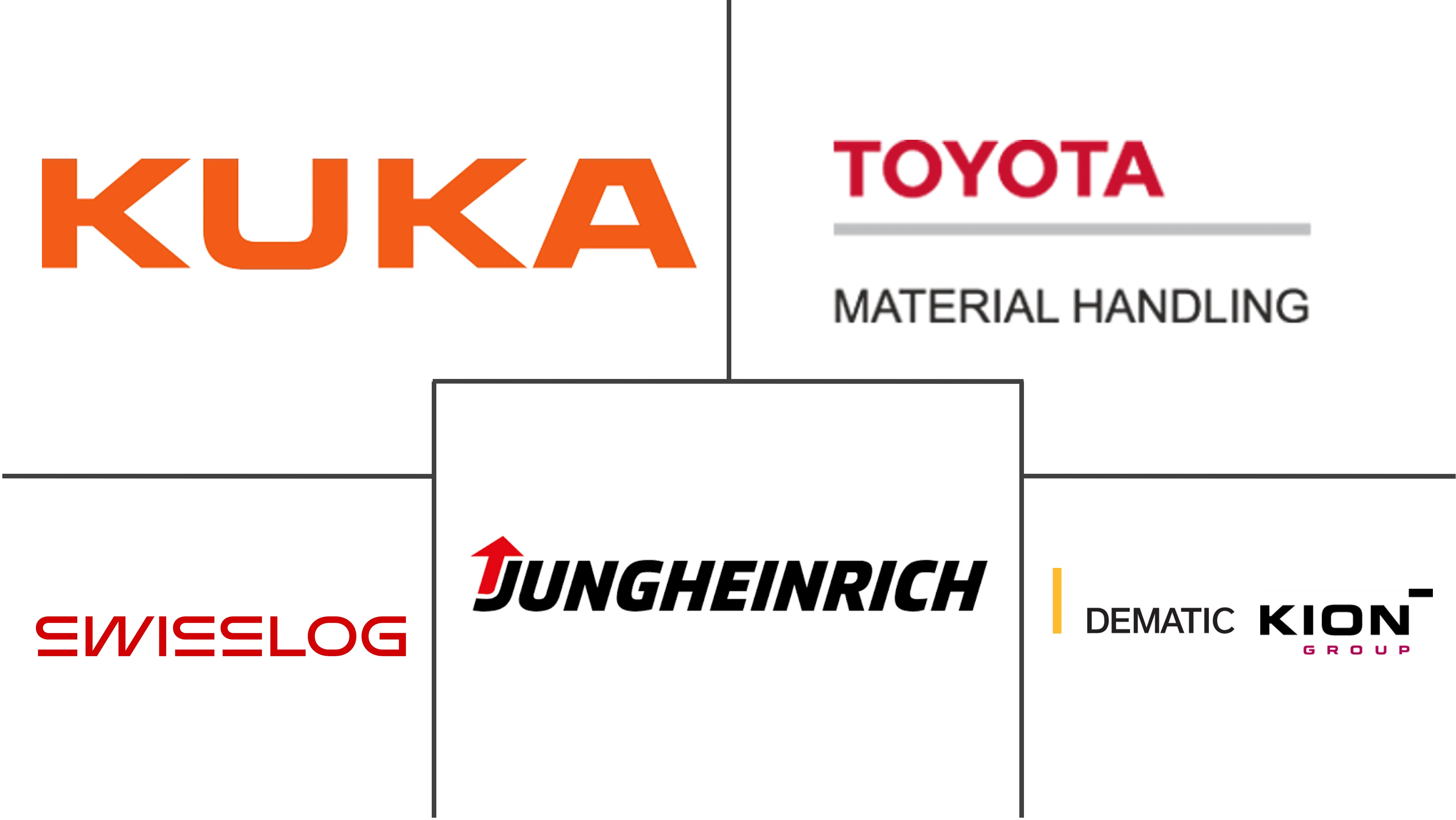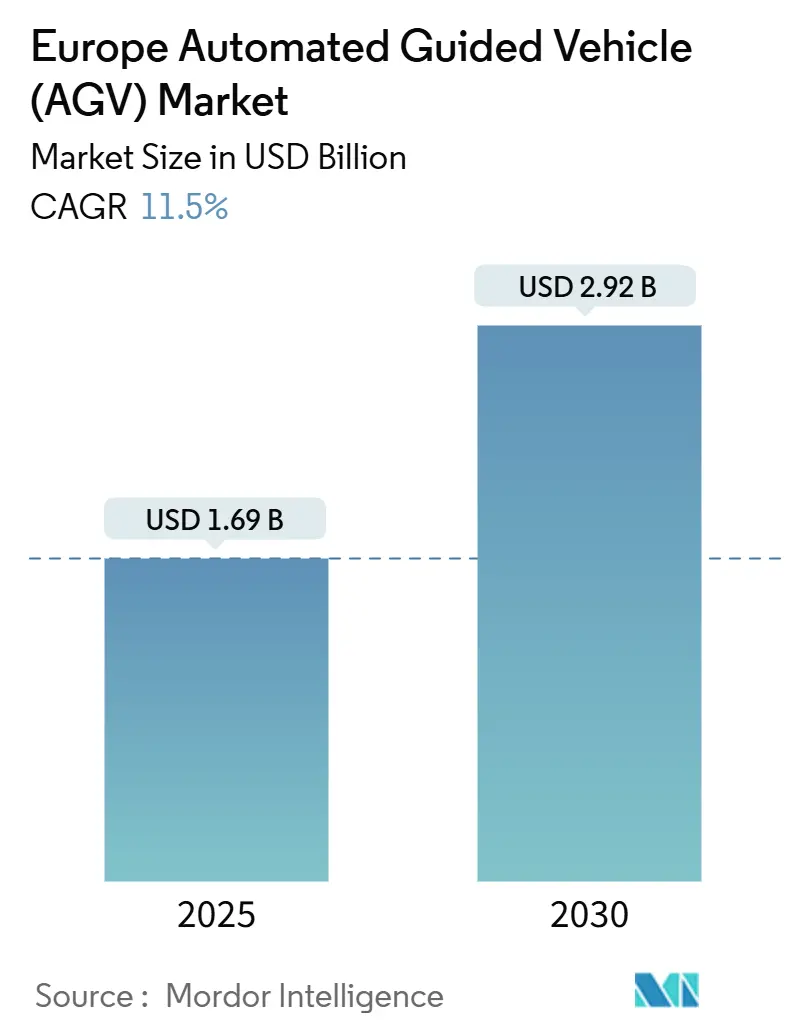
Europe Automated Guided Vehicle (AGV) Market Analysis by Mordor Intelligence
The European AGV market size is valued at USD 1.69 billion in 2025 and is projected to reach USD 2.92 billion by 2030, reflecting an 11.5% CAGR. Growth is driven by flexible manufacturing initiatives in the automotive sector, large-scale port automation programs, and sustained e-commerce expansion that demands high-throughput intralogistics. Lithium-ion powertrains, 5G-enabled fleet orchestration, and AI-based traffic management platforms are converging to raise overall equipment productivity while meeting EU decarbonization targets. Germany’s automation leadership, the Netherlands’ port projects, and the United Kingdom’s response to acute labor shortages serve as powerful adoption catalysts, whereas fragmented RF spectrum and high integration costs still moderate deployment velocity.
Key Report Takeaways
- By vehicle type, automated forklifts led with 38% revenue share in 2024; unit-load carriers are forecast to expand at a 13.2% CAGR through 2030.
- By navigation technology, laser-guided systems held 42% of the European AGV market share in 2024, while vision-guided platforms are advancing at a 14.6% CAGR.
- By battery type, lead-acid systems accounted for 55% share of the European AGV market size in 2024, whereas lithium-ion variants are growing at a 16.4% CAGR to 2030.
- By application, transportation and distribution captured 46% of the European AGV market size in 2024 and packaging/palletizing is progressing at a 14.3% CAGR.
- By end-user industry, automotive operations commanded 30% of the market in 2024, while retail and e-commerce are rising at a 15.1% CAGR.
- The Netherlands’ Maasvlakte II terminal operates 73 electric L-AGVs and has ordered 71 more, underscoring ports’ expanding role in fleet scale-up.
Europe Automated Guided Vehicle (AGV) Market Trends and Insights
Drivers Impact Analysis
| DRIVER | (~) % IMPACT ON CAGR FORECAST | GEOGRAPHIC RELEVANCE | IMPACT TIMELINE |
|---|---|---|---|
| E-commerce fulfilment centres’ surge across urban Europe | +2.1% | Germany, Netherlands, UK, France, Italy | Medium term (2-4 years) |
| Industry 4.0-enabled flexible manufacturing lines in German automotive plants | +1.8% | Germany, Czech Republic, Hungary, Slovakia | Long term (≥ 4 years) |
| Labour-cost inflation & demographic shortages in Western Europe’s logistics workforce | +2.3% | Western Europe | Short term (≤ 2 years) |
| EU Green Deal incentives for low-emission intralogistics equipment | +1.4% | EU-wide | Long term (≥ 4 years) |
| Port automation projects in Rotterdam & Antwerp | +0.9% | Netherlands, Belgium, Germany, France | Medium term (2-4 years) |
| Horizon Europe funding for next-gen swarm navigation algorithms | +0.7% | Germany, France, Sweden, Netherlands | Long term (≥ 4 years) |
| Source: Mordor Intelligence | |||
E-commerce fulfilment centres’ surge across urban Europe
Rapid growth in urban fulfilment hubs is resetting AGV design priorities toward compact footprints and 24/7 availability. REWE Group’s EUR 250 million logistics hub in Magdeburg automates 50% of intralogistics and handles 286,000 packages per day, proving the scale advantages of AGV-centric layouts. Specialty retailers follow suit; Dr. Max’s new Italian warehouse uses mobile robots to sustain 55% online-sales growth. Combined with stabilizing logistics-real-estate vacancies, retailers now negotiate for automation-ready space that supports rapid AGV charging infrastructure.[1]Swisslog, “REWE strengthens logistics with €250 million investment in Magdeburg,” swisslog.com
Industry 4.0-enabled flexible manufacturing lines in German automotive plants
German automakers are dismantling rigid conveyor lines in favor of matrix production orchestrated by AGV fleets. Mercedes-Benz’s body-in-white operations run nearly 100 KUKA vehicles that autonomously synchronize component flows in real time. BMW’s factory implementations rely on AI fleet control software to adapt transport routes to model-mix changes without downtime. Purpose-built paint-shop AGVs such as Dürr’s EcoProFleet expand the concept to finishing lines, allowing multiple vehicle types to run on shared resources.
Labour-cost inflation & demographic shortages in Western Europe’s logistics workforce
A 1.1 million-person staffing gap across European logistics forces operators to accelerate automation. UK surveys show 76% of logistics executives experiencing shortages and 54% prioritizing AGV projects as a continuity measure. Continental robot installations reached 71,000 units in 2024, of which Germany absorbed 36%, indicating heightened reliance on automated transport to stabilize throughput. Suppliers position AGVs as collaborative tools that augment limited human labor rather than replace it outright.
EU Green Deal incentives for low-emission intralogistics equipment
The European Commission’s EUR 422 million Alternative Fuels Infrastructure Facility co-funds charging networks that directly benefit lithium-ion AGV deployments. Additional EUR 40 billion from the Innovation Fund targets energy-intensive industries and battery storage, steering research toward lighter, fast-charging modules. Operators such as APM Terminals already run 73 wind-powered electric L-AGVs and plan to exceed 140 vehicles by 2027.
Restraints Impact Analysis
| RESTRAINTS | (~) % IMPACT ON CAGR FORECAST | GEOGRAPHIC RELEVANCE | IMPACT TIMELINE |
|---|---|---|---|
| High Up-front System Integration & Customisation Costs for SMEs | -1.6% | EU-wide with particular impact on Southern and Eastern Europe | Short term (≤ 2 years) |
| Fragmented European RF Spectrum Causing Network Latency in Dense Warehouses | -0.8% | Germany, Netherlands, UK industrial clusters | Medium term (2-4 years) |
| Lengthy CE-Mark & ISO 3691-4 Safety Certification Lead-Times | -1.2% | EU-wide, particularly affecting new market entrants | Medium term (2-4 years) |
| Limited Availability of Skilled AGV Systems Integrators | -0.9% | Western Europe core markets, spillover to Eastern Europe | Short term (≤ 2 years) |
| Source: Mordor Intelligence | |||
High up-front system integration & customisation costs for SMEs
Many SMEs confront integration quotations exceeding EUR 49,000 for a modest two-AGV installation, stalling broader market penetration. Although payback can arrive within eight months in optimized layouts, limited in-house expertise and low awareness of subsidy programs leave uptake uneven. OECD surveys show 72% of European SMEs understand digital benefits, yet only 18% actively deploy advanced automation due to skills and funding gaps.[2]ResearchGate, “Implementation of Automated Guided Vehicles for the Automation of Selected Processes,” researchgate.net
Fragmented European RF spectrum causing network latency in dense warehouses
AGV fleets rely on ultra-reliable low-latency connectivity, but industrial spectrum policies vary widely across EU states. Germany’s dedicated 3.75 GHz band supports deterministic 5G networks, whereas similar allocations remain patchy elsewhere, complicating multi-site deployments. Studies show 60 GHz links degrade in metallic rack environments, further highlighting the need for harmonized spectrum and advanced network-slicing techniques.
Segment Analysis
By Vehicle Type: Automated forklifts maintain dominance while unit-load carriers accelerate
Automated forklifts captured 38% of the European AGV market share in 2024, underpinned by drop-in compatibility with existing pallet workflows and mature safety certifications. Tow tractors and tug vehicles remain staples in large manufacturing campuses, whereas assembly line platforms support just-in-time automotive sequencing. Unit-load carriers, propelled by e-commerce fulfilment needs, are forecast to grow at a 13.2% CAGR, increasing their contribution to the European AGV market size through 2030.
Technical evolution blurs legacy categories: KION’s KAnIS project demonstrates 5G-linked outdoor forklifts that coordinate with indoor fleets, extending automated coverage to yard areas. Toyota’s alliance with Gideon blends forklift heritage with AI-driven AMRs, revealing how suppliers reposition toward adaptable multi-purpose platforms.
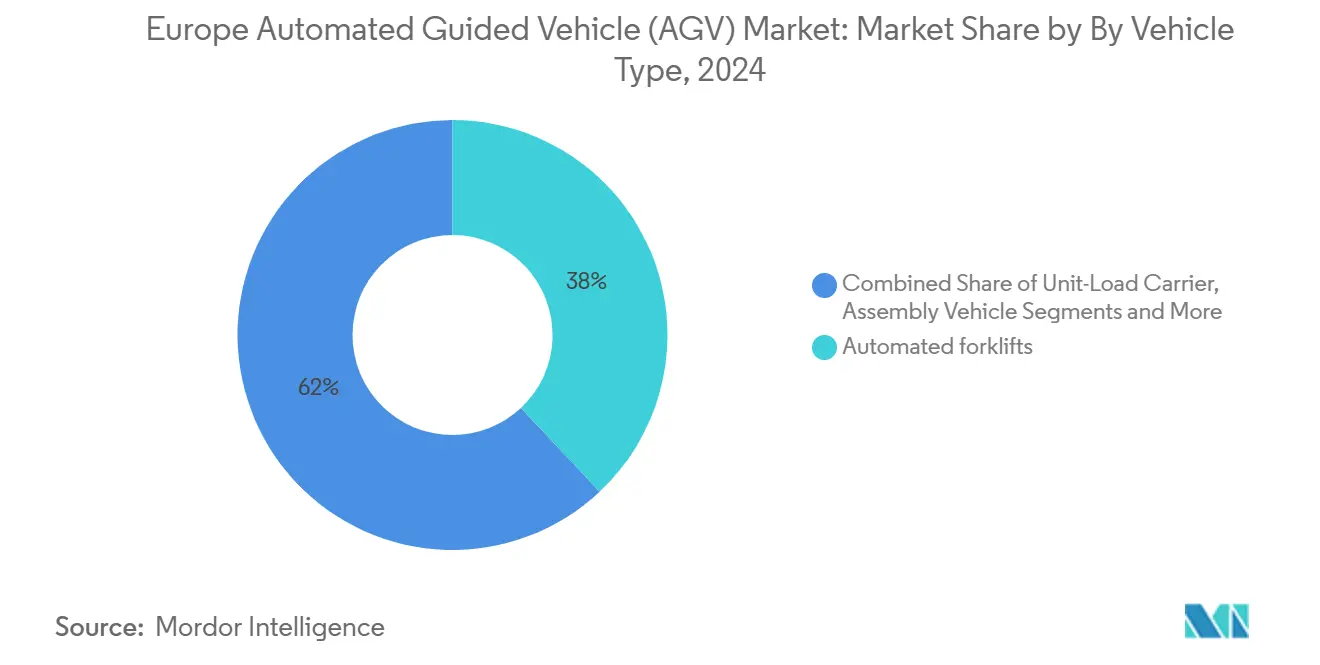
Note: Segment shares of all individual segments available upon report purchase
By Navigation Technology: Vision systems narrow the gap
Laser guidance commanded 42% share in 2024 thanks to proven precision in structured aisles. Vision-guided vehicles, growing at 14.6% CAGR, leverage SLAM and sensor fusion to self-map unpredictable environments, reducing infrastructure retrofits. Magnetic and inductive paths persist in critical path-following use cases such as cold-chain tunnels. Free-navigation research at Fraunhofer IPA shows how hybrid vision-laser stacks eliminate fixed reflectors while preserving millimetric accuracy. Innok Robotics extends this model outdoors with LiDAR plus motion-tracker fusion for rough terrain.[3]Fraunhofer IPA, “Free Navigation for Automated Guided Vehicles,” ipa.fraunhofer.de
By Battery Type: Lithium-ion outpaces legacy chemistries
Lead-acid configurations still represent 55% of installed capacity owing to low entry cost and widespread maintenance know how. Nevertheless, lithium-ion solutions are rising at a 16.4% CAGR on the back of energy density, full-shift autonomy and EU sustainability mandates that favor closed-loop battery recycling. The EU battery regulation and Net-Zero Industrial Act jointly steer capital toward local cell production and second-life programs, reshaping the European AGV market size calculus for fleet operators. APM Terminals’ wind-powered charging ecosystem illustrates continuous-operation potential for large outdoor fleets.
By Mode of Operation: Hybrid systems dominate transition strategies
Most buyers specify manual-override or dual-mode capability to ease workforce acceptance and facilitate progressive automation. Fully autonomous fleets are the fastest-growing subset as 360-degree safety sensors and AI-based obstacle avoidance mature. KION’s AI-trained driverless forklift completed simulation-based learning cycles before entering customer sites, proving viability in brownfield layouts. Hybrid orchestration lowers risk while enabling data-driven path optimization that paves the way to full autonomy.
By Application: Transportation leads, packaging catches up
Transportation and distribution operations accounted for 46% of the European AGV market size in 2024 as pallet moves remain the backbone of warehouse flow. Packaging and palletizing exhibit a 14.3% CAGR through 2030 due to parcel-level automation at fulfilment centers. Integration with AS/RS and robotic picking arms—such as Movu’s eligo achieving 600 picks per hour—highlights the synergistic gains from orchestrated subsystems. AI-enhanced WMS platforms further tune AGV task allocation based on predictive demand patterns.
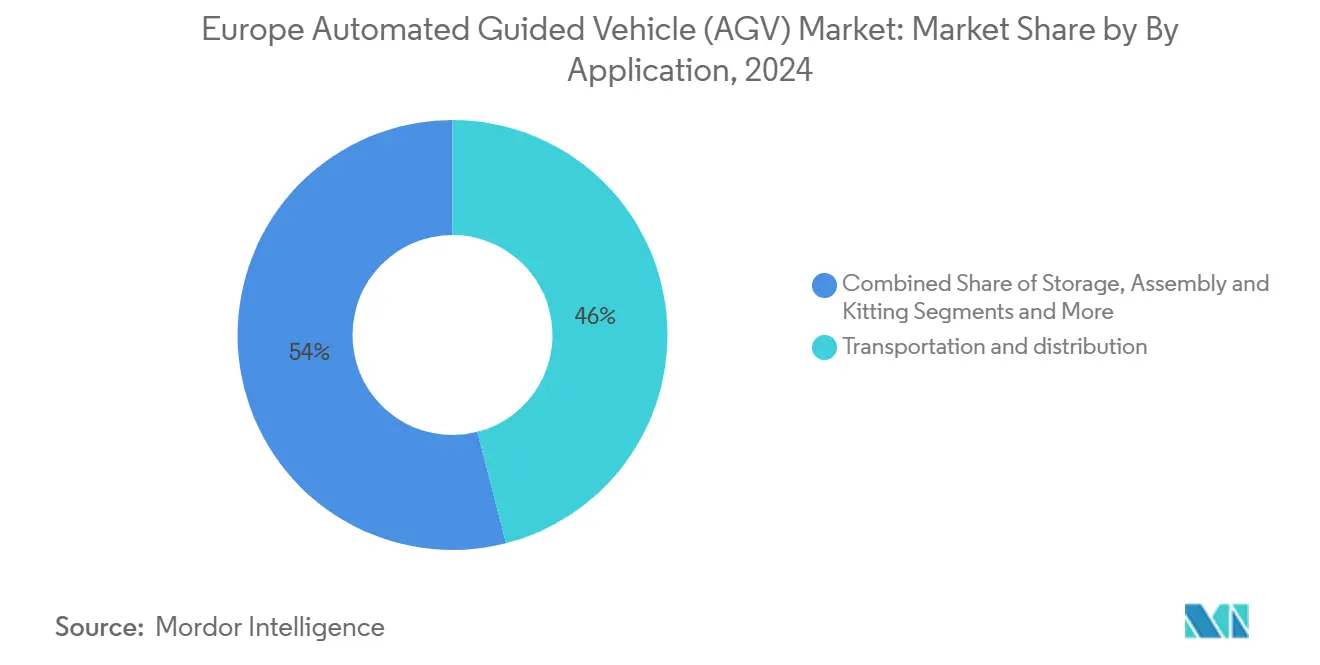
Note: Segment shares of all individual segments available upon report purchase
By End-User Industry: Automotive retains the lead, e-commerce surges
Automotive manufacturers commanded 30% of demand in 2024, capitalizing on modular AGV fleets to manage complex variant scheduling and just-in-time sequencing. Retail and e-commerce, growing at 15.1% CAGR, increasingly favor compact AMRs for micro-fulfilment scenarios inside dense urban footprints. Food and beverage, electronics, and pharmaceuticals each require specialized hygienic or ESD-safe platforms, broadening supplier addressable markets. EU defense funding for autonomous ground systems also seeds dual-use navigation technologies with commercial spillover potential.
Geography Analysis
Germany anchors the European AGV market with its advanced automotive factories, concentrated research institutes, and 36% share of the continent’s 2024 robot installations. OEMs such as Mercedes-Benz, BMW and Volkswagen routinely pilot next-generation fleets before roll-outs across satellite plants, reinforcing a robust domestic supplier base. The Netherlands leverages the Port of Rotterdam’s automation and logistics corridors to create a high-intensity testbed for heavy-duty AGVs, boosting domestic integrator expertise that spills over into Belgium and northern Germany.
The United Kingdom prioritizes AGV adoption to offset persistent labor deficits amplified by demographic trends and Brexit-related labor-mobility changes; 76% of logistics leaders cite staff shortages as their top operational risk, accelerating investment in automated transport. France and Italy scale projects around burgeoning e-commerce nodes and pharmaceutical cold-chain hubs, illustrated by Dr. Max’s automation project in Telgate. Spain, Poland and Czechia represent emerging growth corridors where cross-border e-commerce flows stimulate warehouse modernization, yet SMEs still wrestle with integration costs.
EU-level policy harmonization under the Green Deal and Alternative Fuels Infrastructure Facility channels funds toward charging networks, favoring economies with mature logistics corridors such as Germany, Netherlands and Denmark. However, inconsistent RF spectrum policies hamper pan-European fleet roaming, requiring integrators to customize network architectures on a country-by-country basis. Continued efforts toward 5G spectrum harmonization will unlock multi-site fleet orchestration that further scales the European AGV market.
Competitive Landscape
Market structure remains moderately fragmented as long-established material-handling conglomerates compete head-to-head with pure-play robotics specialists. KION Group, Jungheinrich and Toyota Material Handling Europe leverage brand loyalty, global service coverage and comprehensive product ranges to defend share, while simultaneously partnering with AI firms to upgrade software stacks. MiR, Balyo and AGILOX differentiate through nimble AMR platforms that promise sub-week deployments and cloud-native fleet management.
Strategic collaboration is accelerating: KION’s partnership with NVIDIA and Accenture produced an AI-driven digital-twin platform that simulates entire warehouses, allowing operators to test throughput scenarios virtually before real-world execution. Toyota’s move toward AMRs via Gideon underscores the shift from hardware-centric portfolios toward data-rich orchestration ecosystems. Niche segments—outdoor yard logistics, pharmaceutical cleanrooms, hazardous material handling—offer white-space for specialized integrators that can navigate stringent regulatory frameworks.
Technology convergence around 5G connectivity, edge computing and AI-based traffic management raises entry barriers for late movers yet simultaneously allows software-centric startups to plug value gaps. Over the forecast period, consolidation is likely as full-line operators acquire niche firms to secure proprietary perception stacks or vertical-specific application know-how, reshaping competitive intensity within the European AGV market.
Europe Automated Guided Vehicle (AGV) Industry Leaders
-
KUKA AG
-
Toyota Material Handling Europe AB
-
Jungheinrich AG
-
Swisslog Holding AG
-
Dematic (KION Group)
- *Disclaimer: Major Players sorted in no particular order
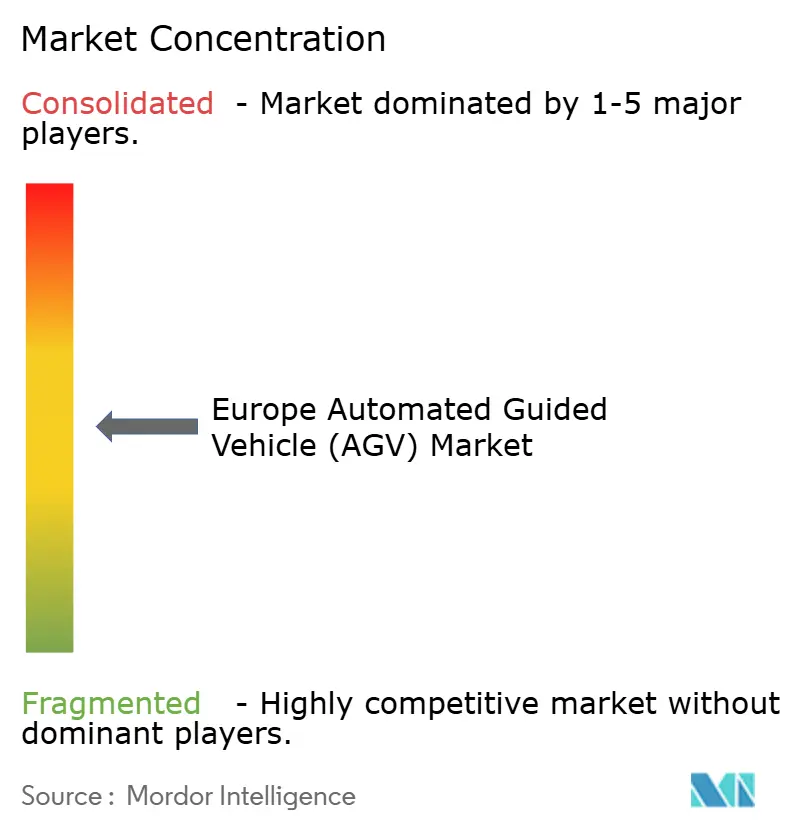
Recent Industry Developments
- January 2025: KION Group partnered with NVIDIA and Accenture to launch AI-powered digital twin technology for warehouse optimization, showcasing the "Mega" blueprint at CES 2025 that enables operators to design efficient configurations and train robot fleets without disrupting operations.
- January 2025: Toyota Industries Corporation announced strategic partnership with Gideon, a Zagreb-based AMR software specialist, marking Toyota's shift from traditional AGVs to flexible autonomous mobile robots with AI-driven deployment capabilities.
- December 2024: KION Group unveiled AI-powered driverless forklift trucks using simulation-based training and imitation learning to navigate complex warehouse environments, targeting both greenfield and brownfield deployment scenarios.
- November 2024: SSI SCHAEFER completed installation of fully automated pallet high bay warehouse for VOG AG, featuring systems capable of handling 180 pallets per hour with WAMAS logistics software integration.
Europe Automated Guided Vehicle (AGV) Market Report Scope
The scope of the study focuses on the market analysis of Europe Automated Guided Vehicle (AGV). The study also tracks the key market parameters, underlying growth influencers, and major vendors operating in the industry, which supports the market estimations and growth rates over the forecast period. The scope of the report encompasses market sizing and forecast for segmentation by product type, by end user industry and by country. The study further analyzes the impact of Covid-19 on the ecosystem.
| Automated Forklift |
| Tow / Tractor / Tug |
| Unit-Load Carrier |
| Assembly Line Vehicle |
| Special-Purpose / Custom |
| Laser Guided |
| Magnetic / Inductive Guided |
| Vision Guided |
| Natural Feature / SLAM |
| Lead-acid |
| Lithium-ion |
| Nickel-Metal Hydride |
| Super-capacitor / Fast-Charge |
| Manual Override |
| Hybrid / Dual-Mode |
| Fully Autonomous |
| Transportation and Distribution |
| Storage and Retrieval |
| Assembly and Kitting |
| Packaging and Palletising |
| Automotive |
| Food and Beverage |
| Retail and E-commerce |
| Electronics and Electrical |
| General Manufacturing |
| Pharmaceuticals |
| Aerospace and Defence |
| Germany |
| United Kingdom |
| France |
| Italy |
| Spain |
| Netherlands |
| Rest of Europe |
| By Vehicle Type | Automated Forklift |
| Tow / Tractor / Tug | |
| Unit-Load Carrier | |
| Assembly Line Vehicle | |
| Special-Purpose / Custom | |
| By Navigation Technology | Laser Guided |
| Magnetic / Inductive Guided | |
| Vision Guided | |
| Natural Feature / SLAM | |
| By Battery Type | Lead-acid |
| Lithium-ion | |
| Nickel-Metal Hydride | |
| Super-capacitor / Fast-Charge | |
| By Mode of Operation | Manual Override |
| Hybrid / Dual-Mode | |
| Fully Autonomous | |
| By Application | Transportation and Distribution |
| Storage and Retrieval | |
| Assembly and Kitting | |
| Packaging and Palletising | |
| By End-User Industry | Automotive |
| Food and Beverage | |
| Retail and E-commerce | |
| Electronics and Electrical | |
| General Manufacturing | |
| Pharmaceuticals | |
| Aerospace and Defence | |
| By Country | Germany |
| United Kingdom | |
| France | |
| Italy | |
| Spain | |
| Netherlands | |
| Rest of Europe |
Key Questions Answered in the Report
What is the current value of the European AGV market?
The European AGV market is valued at USD 1.69 billion in 2025 and is forecast to reach USD 2.92 billion by 2030.
Which vehicle type holds the largest share?
Automated forklifts lead with 38% revenue share in 2024, benefiting from broad application across warehouses and factories.
How fast are lithium-ion AGVs growing in Europe?
Lithium-ion-powered fleets are expanding at a 16.4% CAGR through 2030 as operators pursue longer runtimes and alignment with EU sustainability rules.
Why is the Netherlands important in the European AGV landscape?
Rotterdam’s Maasvlakte II terminal operates one of the world’s largest electric AGV fleets and continues to expand, establishing the Netherlands as a benchmark for maritime automation.
What are the main barriers slowing AGV adoption among European SMEs?
High integration costs, limited technical skills, and low awareness of subsidy programs hinder uptake, particularly in Southern and Eastern Europe.
How do EU policies influence AGV deployment?
Green Deal funding for charging infrastructure and battery innovation, coupled with evolving 5G spectrum regulations, directly shapes technology choices and deployment speed across the region.
Page last updated on:
